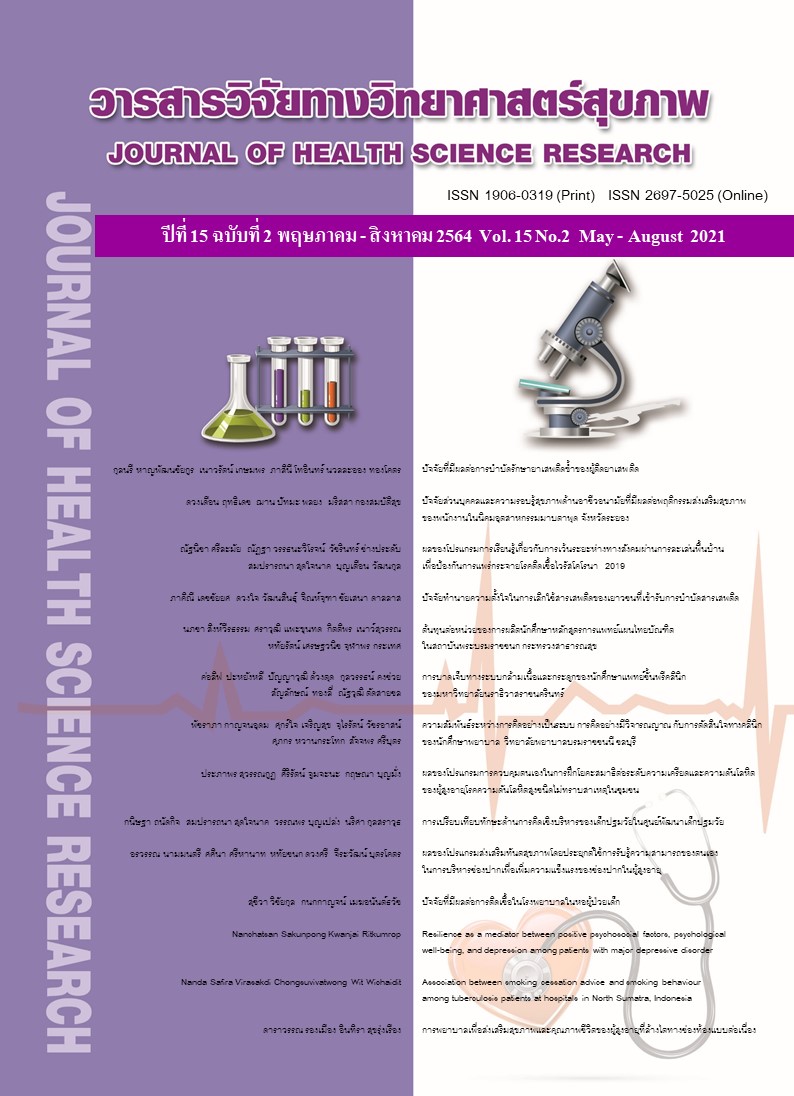ปัจจัยทำนายความตั้งใจในการเลิกใช้สารเสพติดของเยาวชน ที่เข้ารับการบำบัดสารเสพติด
Main Article Content
บทคัดย่อ
Background: Promoting the intent to abstain from drugsamong youths receiving substance abuse treatment is an essential factor for helping youth to truly quit substance abuse and to prevent the relapse of addiction.
Objectives: This research aimed to explore the intention to abstain from drugs and determine factors predicting the intention to drug abstinence among youths receiving substance abuse treatment.
Methods: This research was the predictive correlational design. The sample consisted of 270 youths undergoing a substance abuse treatment program at Wiwatphonlamuang School in Eastern Thailand who were recruited by the simple random sampling technique. The data were collected by nine self-administered questionnaires. Descriptive statistics, Pearson’s product moment correlation coefficient, and Stepwise multiple regression were employed for data analyses.
Results: The results revealed that 45.20% of youths receiving substance abuse treatment had a medium-high level of the intention to abstain from drugs. Results of stepwise multiple regression analyses revealed that psychological flexibility (β=.323, p<.001), resilience (β=.121, p<.05), friendship intimacy (β=-.191, p<.01), and social support (β=.148, p<.05) could together explain 18.10 percent of the variance for the intention to abstain from drugs among youths receiving substance abuse treatment (R2=.181, F4, 265 = 15.884; p < .001).
Conclusions: psychological flexibility resilience friendship intimacy and social support of the variance for the intention to abstain from drugs among youths receiving substance abuse treatment.
Downloads
Article Details
บทความที่ได้รับการตีพิมพ์เป็นลิขสิทธิ์ของวิทยาลัยพยาบาลบรมราชชนนี จังหวัดนนทบุรี
ข้อความที่ปรากฏในบทความแต่ละเรื่องในวารสารวิชาการเล่มนี้เป็นความคิดเห็นส่วนตัวของผู้เขียนแต่ละท่านไม่เกี่ยวข้องกับวิทยาลัยพยาบาลบรมราชชนนี จังหวัดนนทบุรี และคณาจารย์ท่านอื่น ในวิทยาลัยฯ แต่อย่างใด ความรับผิดชอบองค์ประกอบทั้งหมดของบทความแต่ละเรื่องเป็นของผู้เขียนแต่ละท่าน หากมีความผิดพลาดใด ๆ ผู้เขียนแต่ละท่านจะรับผิดชอบบทความของตนเองแต่ผู้เดียว
เอกสารอ้างอิง
United Nations Office on Drugs and Crime (UNODC). World Drug Report 2020. Vienna, Austria United Nations publication; 2020.
Substance Abuse and Mental Health Service Administration: SAMHSA. Results from the 2015 national survey on drug use and health: detailed tables. RTI International, Research Triangle Park, North Carolina; 2016.
Office of Narcotics. Nationwide Narcotics Results 2016. [Internet]. 2017 [cited 30 Dec 2020]. Available from: http://www. oncb.go.th/DocLib/2559.pdf.
Boromarajonani National Institute of Drug Addiction Treatment and Rehabilitation. statistics on drug addicts of Boromarajonani National Institute of Drug Addiction Treatment and Rehabilitation in the fiscal year 2018-2020. 2020 [cited 2020 Dec 30]. Available from http://www.pmnidat.go.th/.
Substance Abuse and Mental Health Services Administration: SAMHSA. Key substance use and mental health indicators in the United States: Results from the 2019 National Survey on Drug Use and Health. Rockville: SAMHSA; 2019.
Nitayawan S, Rungsiwaroj N, Phajuy A. The process of treatment among drug dependentpatient. Journal of Nurses Association of Thailand Northern Office. 2018;24(1):15-27.(in thai).
Ahern J, Stuber J, Galea S. Stigma, discrimination and the health of illicit drug users. Drug Alcohol Depend, 2007;88(2-3): 188-96. doi: 10.1016/j.drugalcdep.2006.10.014.
Sirinuan S, Suphankul P, NooSorn N, Wongsawat P. Factors affecting amphetamine relapse among drug addicts after treatment. Journal of Health Sciences Research. 2016;10(1):39-45. (in Thai).
Deepana A, Numkham L, Wattanasoei S. Factors affecting intention to alcohol absinence among the dependence stroe employee in Nan province. Thai Science and Technology Journal. 2020;28(1):168-81. (in Thai).
Kaewmart N, Dallas JC, Poonnotok P, Dethchaiyot P, Bunpracha S. Factors affecting the intention of drug abstinence among youth experiencing substance abuse. Journal of Health Science Research. 2017;11(1):133-41. (in Thai).
Amnajkitikorn W. Self-concept, Social Anxiety and intention for abstinence of drug addicts in Chiang Mai drug dependence treatment center [Thesis]. Chiang Mai: Chiang Mai University; 2009. (in Thai).
Ajzen I. The theory of planned behavior. Organizational Behavior and Human decision Processes. 1991;50(2):179-211. doi: 10.1016/0749-5978(91)90020-T.
Silpakit P, Silpakit O. The psychometric property of Rosenberg Self-esteem Scale in Thai youth. Journal Mental Health Thai. 2016;24(1):15-28. (in Thai).
Parinyaphol P. Resilience of University Students of Prince of Songkla University, Pattani Campus. Songklanakarin Journal of Social Sciences and Humanities. 2007;13(2):137-53. (in Thai).
Suntornvijitr S, Hengudomsub P, Vatanasin D, Detchaiyot P. Predicting factors of depression among secondary school students in extended educational opportunity schools. Nursing Journal of the Ministry of Public Health. 2018;28(2):53-66. (in Thai).
Luoma J, Drake CE, Kohlenberg BS, Hayes SC. Substance abuse and psychological flexibility: The development of a new measure. Addict Res Theory. 2011;19(1) :3-13. doi: 10.3109/16066359.2010.524956.
Gillandersa DT, Bolderstonb H, Bondc FW, Dempsterd M, Flaxmane PE, Campbelld E, et al. The development and initial validation of the cognitive fusion questionnaire. Behav Ther. 2014;45(1):83-101. doi: 10.101 6/j.beth.2013.09.001.
Luoma JB, Nobles RH, Drake CE, Hayes SC, O’Hair A, Fletcher L, Kohlenberg BS. Self-stigma in substance abuse: development of a new measure. J Psychopathol Behav Assess. 2013;35(2):223-34. doi: 10.1007/s 10862-012-9323-4.
Nateethan M, Tungpunkom P, Wiwatkunupakan S. Factors influencing depression of adolescents in Muang district Chiang Mai province. Journal of Nursing. 2004;31(2):74-86. (in Thai).
Hongsutthi P, Hengudomsub P, Vatanasin D. Factors influencing preventive behaviors for drugaddiction among male students of extended educational opportunity schools. Journal of Boromarajonani College of Nursing, Bangkok. 2017;33(3):112-23. (in Thai).
Hayes SC, Luoma JB, Bond FW, Masuda A, Lillis J. Acceptance and Commitment Therapy: model, processes, and outcomes. Behav Res Ther. 2006;44(1):1-25. doi: 10.1016/j.brat.2005.06.006.
Purahong G. Factors affecting relapsing drug addicted patients in Pathumthani Province.Journal of Public Health Nursing. 2018;32(2):23-40. (in Thai).
Yeepoo C, Kongthong U, Sriherun B. The development of a learning activity model for reducing and stop smoking behavior of drug addiction for children adolescent patients. Valaya Alongkorn Review (Humanities and Social Science). 2018;8(1): 131-46. (in Thai).
Grotberg E. A guide to promoting resilience in children: Strengthening the human spirit. The Hague Netherlands: Bernard van Leer Foundation; 1995.
Nintachan P. Strength in Life: Concept, evaluation, and application. Resilience: concept, evaluation, and adaptation. Bangkok: Point thong company limited; 2015. (in Thai).


